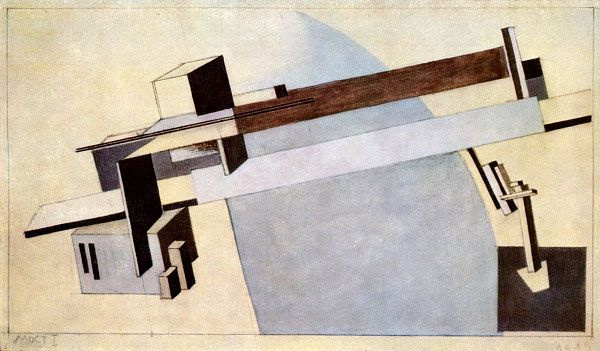log in
Enter site
Login to use Arthive functionality to the maximum
Proun 1A, the Bridge I
El Lissitzky • Painting, 1919
Description of the artwork «Proun 1A, the Bridge I»
The beginning of the twentieth century in Soviet Russia was a period of widespread dissemination of the vast number of abbreviations and acronyms. In fact coined the word Lissitzky "Proun" is also an abbreviation ("new project approval"). It's not a painting in the conventional sense, and not the plan of architectural structures. Here he writes about the fundamental the artist himself: "We saw that the new paintings, created by us, is not a picture. It generally represents nothing but design space, planes, lines with the aim to create a system of new relations of the real world. And this new structure we have given the name Proun".
"Proun 1A, the Bridge I" one of the earliest such works by Lissitzky. At first, he often gave them "architectural" titles, later renounced it, so as not to limit the perception of the viewer. Two-dimensional and three-dimensional is not to join in the confrontation, and become allies, creating a completely unique image. Sharp, crisp lines and minimal color would seem to leave little to the imagination, but wonderfully create dimensional vision of the picture. The viewer sees her as if from all directions at once, gets an opportunity to "rotate" the image and see it from a different angle. The apparent imbalance and asymmetry of the composition attracts the eye. First he fixed on a dynamic left part of the picture, then as if by itself, it slides to the right and up, and finally falling into a black square in the lower right corner.
Lissitzky does not overload their fundamental heavy visual elements, his designs simple and elegant. And here, as in most of his works, he tries to convey to the audience that his constructivist works are not only paintings, but also on the idea that you can make in real life with architecture and sculpture.
Author: Eugene Sidelnikov
"Proun 1A, the Bridge I" one of the earliest such works by Lissitzky. At first, he often gave them "architectural" titles, later renounced it, so as not to limit the perception of the viewer. Two-dimensional and three-dimensional is not to join in the confrontation, and become allies, creating a completely unique image. Sharp, crisp lines and minimal color would seem to leave little to the imagination, but wonderfully create dimensional vision of the picture. The viewer sees her as if from all directions at once, gets an opportunity to "rotate" the image and see it from a different angle. The apparent imbalance and asymmetry of the composition attracts the eye. First he fixed on a dynamic left part of the picture, then as if by itself, it slides to the right and up, and finally falling into a black square in the lower right corner.
Lissitzky does not overload their fundamental heavy visual elements, his designs simple and elegant. And here, as in most of his works, he tries to convey to the audience that his constructivist works are not only paintings, but also on the idea that you can make in real life with architecture and sculpture.
Author: Eugene Sidelnikov


